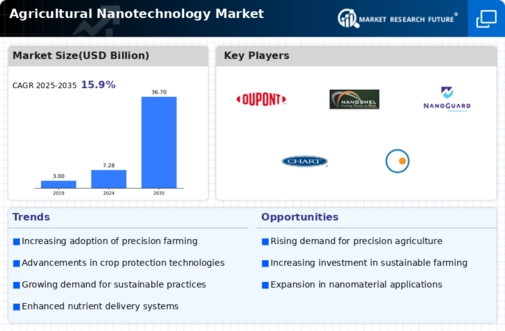Market Growth Projections
Government Support and Funding
Government initiatives and funding play a crucial role in shaping the Global Agricultural Nanotechnology Market Industry. Various countries are increasingly recognizing the potential of nanotechnology in agriculture and are investing in research and development. For instance, grants and subsidies are being allocated to projects that explore the application of nanotechnology in pest control and crop enhancement. This financial support not only fosters innovation but also encourages collaboration between academia and industry. As a result, the market is expected to benefit from enhanced technological advancements and increased adoption of nanotechnology solutions in agricultural practices.
Growing Awareness of Food Safety
The Global Agricultural Nanotechnology Market Industry is also driven by a heightened awareness of food safety among consumers. As concerns regarding pesticide residues and food contamination grow, there is a shift towards safer agricultural practices. Nanotechnology offers solutions such as nano-encapsulation, which can protect active ingredients in pesticides and fertilizers, thereby reducing their environmental footprint. This trend towards safer food production is likely to encourage the adoption of nanotechnology in agriculture, contributing to the market's expansion. The increasing consumer demand for safe and healthy food options aligns with the projected growth of the market.
Emergence of Precision Agriculture
The emergence of precision agriculture significantly impacts the Global Agricultural Nanotechnology Market Industry. This approach utilizes advanced technologies, including nanotechnology, to optimize farming practices. By employing nanosensors and nanomaterials, farmers can achieve precise application of inputs, leading to improved crop management and reduced waste. For example, nanosensors can provide real-time data on soil moisture levels, enabling targeted irrigation. This precision not only enhances productivity but also conserves resources, making agriculture more sustainable. As precision agriculture gains traction, it is expected to drive the demand for nanotechnology solutions, further fueling market growth.
Advancements in Nanotechnology Research
Ongoing advancements in nanotechnology research significantly influence the Global Agricultural Nanotechnology Market Industry. Innovations in material science and engineering enable the development of novel nanomaterials that can be applied in agriculture. For example, the creation of nanosensors allows for real-time monitoring of soil conditions, which can optimize irrigation and fertilization practices. Such technological progress not only enhances agricultural productivity but also contributes to resource conservation. As research continues to evolve, it is likely to propel the market's growth trajectory, aligning with the projected CAGR of 15.85% from 2025 to 2035.
Rising Demand for Sustainable Agriculture
The Global Agricultural Nanotechnology Market Industry is witnessing an increasing demand for sustainable agricultural practices. As global populations rise, the need for efficient food production intensifies. Nanotechnology offers innovative solutions such as nano-fertilizers and nano-pesticides, which enhance crop yield while minimizing environmental impact. For instance, the use of nano-fertilizers can improve nutrient uptake efficiency, potentially reducing the quantity of fertilizers needed. This shift towards sustainability is projected to drive the market from 7.28 USD Billion in 2024 to 36.7 USD Billion by 2035, reflecting a growing awareness of environmental stewardship in agriculture.
















